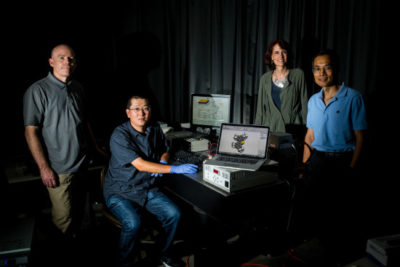UMKC researchers develop a dramatically less expensive material
Just a dollar per gram instead of $100.
That’s how much a new material — nicknamed PCA-1 — costs compared to what is currently used in high-performing perovskite solar cells. At the same time, PCA-1 greatly simplifies the fabrication process and improves device performance in terms of both efficiency and stability. This remarkable and potentially game-changing material was developed by chemistry researchers at the University of Missouri-Kansas City.
The UMKC team’s discovery, led by Curators’ Professors Zhonghua Peng and Kathleen Kilway, was recently published in a top peer-reviewed journal, Advanced Energy Materials.
“This discovery leaps over a major hurdle in making solar power less expensive. The potential value is immense, because solar power is non-polluting and inexhaustible.”
-UMKC Chancellor C. Mauli Agrawal
Solar power, generated by silicon solar cells, remains much more expensive than power resulting from burning of fossil fuels. An emerging form of solar cell called perovskite solar cells has become the new star of the solar industry and the focus of research over the past decade.
Perovskite cells can generate as much power as silicon solar cells, but can be produced at a drastically lower cost by using simpler and easier fabrication processes, among other appealing merits. To function well, perovskite solar cells need to incorporate highly effective charge transporting materials in the device — that’s where UMKC’s PCA-1 comes in.
“The current state-of-the-art material used for transporting positive charges is extremely expensive, costing around $100 per gram for material expense alone,” said Yong Li, one of the UMKC researchers. “In addition, a complicated, so-called doping process is required to make it an effective charge transporter. To make it worse, the doped material tends to attract moisture that is detrimental to the stability of the perovskite.”
PCA-1, on the other hand, is easy to synthesize and takes only two to three simple steps from inexpensive starting compounds. “The material cost for PCA-1 can potentially be as low as $1 per gram,” Kilway said.

Furthermore, “PCA-1 is found to exhibit high instrinsic charge moibility and thus does not require any doping, greatly simplifing the fabrication process,“ Peng said. “In addition, PCA-1 is hydrophobic, having no moisture attracting oxygen or nitrogen atoms, and can form dense and uniform film on top of perovskite, forming an excellent moisture barrier layer for the perovskite underneath.“
The UMKC team has demonstrated that PCA-1 can lead to perovskite solar cells with near record-setting efficiencies and significantly improved long-term stability.
>Father-daughter UMKC alums are renewable-energy powerhouses; Mark Gardner is largest solar developer in Missouri
“This study reveals that PCA-1 is an ideal charge-transporting material for perovskite solar cells,” Peng said. “We will continue this project, and anticipate further performance and stability improvements with the utilization of state-of-the-art perovskite materials.”
Other co-authors on the journal article are graduate student Kyle Scheel and research associate Robert Clevenger of UMKC; and Wan Shou and Heng Pan from Missouri University of Science and Technology.
Funding for the research came from the National Science Foundation, the University of Missouri System Fast Track program, the Interdisciplinary Intercampus research program, the College of Arts and Sciences and the Curators Professorship funds.

